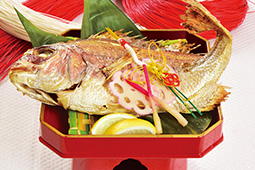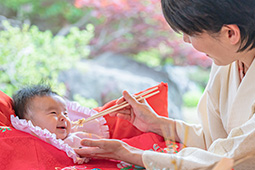May 2023
- English
- 日本語
Whole Sea Bream: An Indispensable Food in Japan's Traditional Okuizome Ceremony
-

A whole sea bream (the grilled fish on the left) is an indispensable part of the meal, in addition to the staple sekihan (rice boiled with red beans) and the side dishes. -

Parents pretend to be feeding a baby, who has not even grown teeth yet, using chopsticks in an okuizome ceremony
-

Preparing the okuizome tray (the fish-shaped object in the bottom center part of the photo is the so-called hagatame-no-ishi, or "tooth-hardening stone," which symbolizes a wish for the baby to grow strong teeth) -

A whole grilled sea bream prepared for an okuizome ceremony -

A family performs an okuizome ceremony to pray for their baby's health and happiness.

A dish of a whole sea bream, okashira-tsuki* style, is an indispensable part of the Japanese traditional ceremony okuizome (literally "first meal"), which is performed on the 100th day after a child's birth. Ido Rieko, a researcher in the field of folk information technology, explains the origin and meaning of this custom.
Ido explains that okuizome is a ceremony in which the baby is imitatively fed for the first time. Performed with the hope that the child will grow up healthy and benefit from a rich diet, it is in principle a family ceremony, in which the baby plays the main part, surrounded by the parents and grandparents. The origin of this custom dates back to the Heian period (late 8th century to the end of 12th century). Since ancient times, Japanese people have considered food extremely precious, as expressed in the belief that "to eat is to sustain life." The ceremony has been passed down for more than 1,000 years to teach children the importance of eating with chopsticks through the okuizome ceremony.

According to Ido, it has also been called hashi-hajime ("chopstick initiation"), because parents use chopsticks to put food up to the baby's mouth.

The selection of tableware and food ingredients used in the okuizome ceremony also expresses a wish for the baby's healthy growth. Food is served in festive lacquerware in vermilion, the color of good luck and protection from evil. Seki-han (literally "red rice," rice boiled with red beans) or a bowl heaping-full of white rice, and a whole grilled sea bream, called "celebratory sea bream," are indispensable.

"Since ancient times, a fish grilled whole, with the head and tail attached, has been considered an auspicious dish, based on the concept of 'accomplishing one thing from beginning to end.' The sea bream also embodies a wish for longevity, since they are known to live longer than other fish. Some live up for as long as 40 years. Furthermore, this dish also expresses a wish that, just like the omnivorous sea bream, the child will be able to eat anything," explains Ido.
In the traditional okuizome ceremony, a pebble or a substitute for a pebble is prepared along with the food. After the parents place food up to the baby's mouth, pretending to feed it, at the end they touch the pebble with the tip of the chopsticks, and then place the tip on the baby's gums several times. This is an expression of the wish for the baby to have strong teeth.
The okuizome ceremony is often celebrated by relatives and friends, in addition to the baby's parents and grandparents. The modern okuizome is an occasion for directly introducing the baby to people outside the home, and it is an opportunity to strengthen family ties. As an auspicious fish, the sea bream is a much valued symbol of this tradition.

* A whole fish, served with the head and tail attached. A whole grilled sea bream, in particular, is a favorite celebratory dish in Japan.

